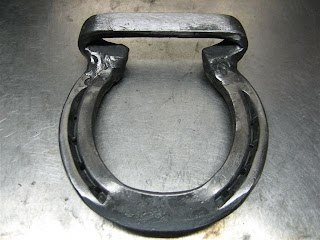A 14 year-old, warm-blood mare presented for a sudden swelling along the upper region (2 inches below the carpus on the back of the leg) of the flexor tendons in the left forelimb. The mare was mildly to moderately positive to palpation of the swelling yet no obvious lameness was observed when trotted in hand. Careful palpation of the area isolated the swelling to the distal check ligament/deep digital flexor tendon area of the proximal metacarpus. Approximately 2-3 inches below the knee/carpus of a horse, 4 soft tissue structures can be identified on ultrasound exam (Figure 1). The ligaments and tendons are typically assessed in a cross-sectional plane (Figure 1-3) and in a longitudinal plane (Figure 4). The most superficial is the superficial digital flexor tendon (SDF), followed by the deep digital flexor tendon (DDF), followed by the distal check ligament, and finally the deepest soft tissue structure which is the proximal suspensory ligament. The first two structures (DDF and SDF) are tendons and should appear identical with regards to brightness (echogenicity) on ultrasound. The deep structures (check ligament and suspensory) are ligaments and tend to be brighter on ultrasound exam when compared to the tendons. The overall echogenicity should be the same or homogeneous throughout the body of the tendons and ligaments.
 |
| Figure 1 |
In Figure 2, a clear, black lesion is identified along the outside/lateral aspect of the distal check ligament. The entire image appears slightly side-ways or oblique in order to optimize visualization of the ligament injury (Red circle in Figure 3). The "black hole" or core lesion corresponds to an area of ligament fiber disruption, edema, and possible blood accumulation.
 |
| Figure 2 |
 |
| Figure 3 |
In Figure 4, the same area is examined in a longitudinal plane to assess the extent of the fiber disruption. The area of disrupted ligament appears to include nearly the entire length of the distal check ligament. Although there is significant edema and contrast between the check ligament and the surrounding structures, the ligament appears to be intact. On a scale of mild, moderate, and severe, I would grade this as moderate with regards to degree of injury to the distal check ligament.
 |
| Figure 4 |
The image in Figure 5 is a simultaneous cross sectional and longitudinal image of the injured ligament. Of all the soft tissue structures to injure in this region of the horse's limb, the distal check ligament is the least important with regards to long term prognosis and return to work. In my experience, many horses with this injury demonstrate little if any lameness at the time of injury but an obvious swelling is always present. Lameness in these horses is typically reserved for the severe injuries which involve a tear of the distal check ligament.
 |
| Figure 5 |
Care for horses with this type of injury include forced rest, ice, topical anti-inflammatory medication (Surpass cream), platelet rich plasma injection (PRP), and extra-corporeal shockwave treatment. At a minimum, the horse needs to be stalled with hand walking only for 6-8 weeks followed by 6-8 weeks of a controlled rehab program. During this time, daily ice treatment is ideal. However, I have had patients that did not agree to the stall rest and were merely turned out for several months. These horses healed with a prominent thickness to the ligament but were sound and return to full work. In my experience, the combination of PRP injection followed by a series of shockwave treatment results in a smaller scar (thickening of the ligament). I have been involved in 2 cases that resulted in surgery to remove the distal check ligament. In one case, the ligament had been injected with cortisone which resulted in abscessation of the ligament and in the second case, the injury was not allowed to heal properly before returning the horse to work! Although these types of injury have a good prognosis for full return to work, the horse does need time off and I strongly recommend regular evaluations for soundness and follow-up ultrasound exam.



























